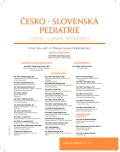Childhood cancer registry
Authors:
D. Kodýtková 1; D. Klimeš 2; V. Bajčiová 1; V. Šmelhaus 3; J. Štěrba 1
Authors‘ workplace:
Klinika dětské onkologie FN a LF MU, Brno, přednosta prof. MUDr. J. Štěrba, Ph. D.
1; Institut biostatistiky a analýz, PřF a LF MU, Brno, ředitel doc. RNDr. L. Dušek, Ph. D.
2; Klinika dětské hematologie a onkologie 2. LF UK a FN Motol, Praha, přednosta prof. MUDr. J. Starý, CSc.
3
Published in:
Čes-slov Pediat 2016; 71 (7-8): 362-365.
Category:
Original Papers
Přednáška na téma „Význam informačního systému“, jejímiž autory byli Kodytková D. a Klimeš D., byla přednesena na XXII. konferenci dětských hematologů a onkologů ČR a SR, Bratislava, 2012.
Overview
The specifics of childhood tumours have over time necessitated an age-specific classification in order to reliably and reproducibly describe and analyze the process and outcomes of childhood cancer treatment. Moreover, the advances in understanding the biology of tumours in children and young adults has brought about the need for further related changes to classification methods, which are currently probably best-reflected in the international standards of the ICCC (International Classification for Childhood Cancer) [1]. As is the case with adults, there has been a statutory requirement in force since 1951 [2] to report any new occurrence of paediatric oncological disease to the National Cancer Registry (NCR), using the ICD-O (International Classification of Diseases for Oncology) [3].
The need for a qualified and reliable interpretation of clinical and laboratory data – such as the ICD-O, ICCC and other individual diagnosis-specific classification systems – has in turn created the need for a reliable and user-friendly information system (IS) which would allow for a flexible response to current developments and automatic data transfer to the NCR and a subsequent analysis of this. Thanks to the cooperation between the University Hospital’s Department of Paediatric Oncology at Masaryk University’s Faculty of Medicine and the Institute of Biostatistics and Analyses (IBA), an IS using both classification standards was developed.
Compared to the NCR, the spectrum of collected and analyzed data was extended according to the needs of the clinics, and so it is possible to use the IS to obtain structured information such as newly-diagnosed patients, the incidence of various types of tumours in children in different areas of the Czech Republic, individual diagnostic groups, therapeutic protocols used, and treatment outcomes and survival curves for overall survival and disease-free survival rates. Upon successful verification of the information system’s initial studies in clinical conditions, it was subsequently implemented at the Department of Paediatric Haematology and Oncology, Motol University Hospital in Prague.
The IS has proved its worth in clinical conditions, and is an invaluable source of reliable data for both oncologists and researchers, as well as for health care financing..
Key words:
information system, paediatric oncology, oncology reporting, classification of tumours
Sources
1. Steliarova-Foucher E, Stiller C, Lacour B, Kaatsch P. International Classification of Childhood Cancer. 3rd ed. Cancer 2005; 103 (7): 1457–1467.
2. Vyhláška ze dne 2. 7. 1953 o povinném hlášení zhoubných nádorů. Epravo.cz [online]. [cit. 2016-07-06]. Dostupné z: http://www.epravo.cz/vyhledavani-aspi/?Id=27375&Section=1&IdPara=1&ParaC=2.
3. Fritz AG. International Classification of Diseases for Oncology: ICD-O. 3rd ed, 1st revision. Geneva: World Health Organization, 2013. ISBN 9789241548496.
4. Výnos MZSV ČSR č. 3/1989 Věstníku MZSV ČSR. Ústav zdravotnických informací a statistiky ČR [online]. [cit. 2016-07-06]. Dostupné z: http://www.uzis.cz/registry-nzis/nor.
5. Národní onkologický registr (NOR). Věstník MZ ČR, částka 14, ročník 2001. Ústav zdravotnických informací a statistiky [online]. [cit. 2016-08-19]. Dostupné z: http://www.uzis.cz/registry-nzis/nor.
6. Koutecký J. Život mezi beznadějí a úspěchem. 1. vyd. Praha: Academia, Paměť sv. 16, 2008: 1–504. ISBN 978-80-200-1672-0.
7. Solidní nádory dětského věku. Česká onkologická společnost České lékařské společnosti Jana Evangelisty Purkyně [online]. [cit. 2016-08-25]. Dostupné z: http://www.linkos.cz/vekove-skupiny/solidni-nadory-detskeho-veku/.
8. Louis DN, Perry A, Reifenberger G, et al. The 2016 World Health Organization Classification of Tumours of the Central Nervous System: a summary. Acta Neuropathol 2016 Jun; 131 (6): 803–820. doi 10.1007/s00401-016-1545-1.
Labels
Neonatology Paediatrics General practitioner for children and adolescentsArticle was published in
Czech-Slovak Pediatrics

2016 Issue 7-8
Most read in this issue
- TB meningitis in the Czech Republic – new encounter with an old diagnosis after 20 years
- The current situation in children TB in Slovakia
- Incidence of tuberculosis at children in the Czech Republic in years 2000–2015
- Tuberculosis in Children – some issues
